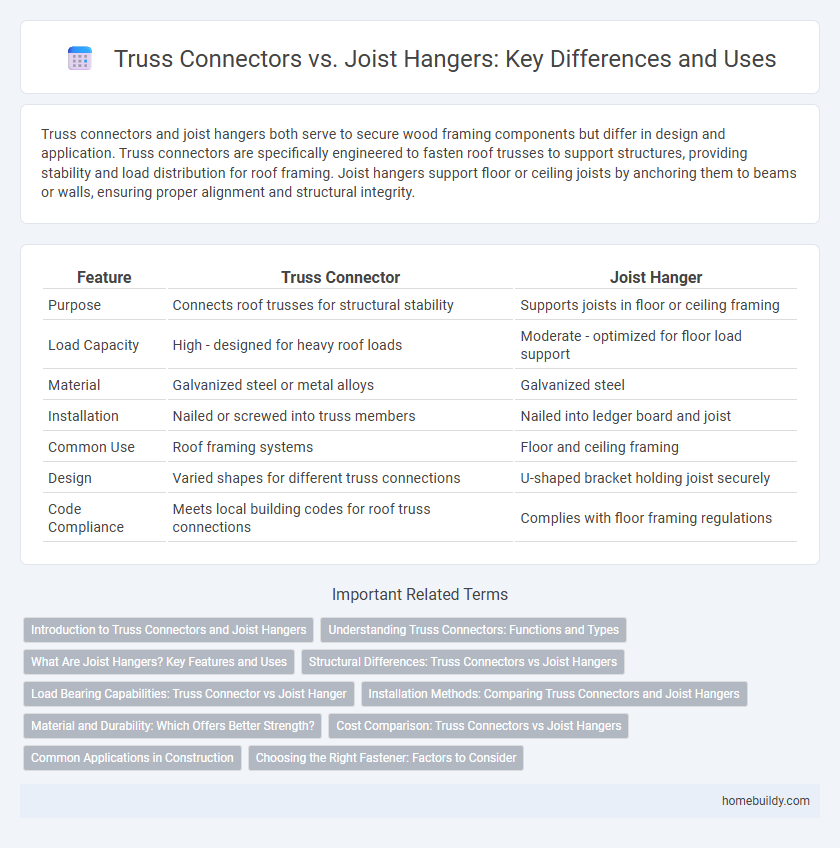Truss connectors and joist hangers both serve to secure wood framing components but differ in design and application. Truss connectors are specifically engineered to fasten roof trusses to support structures, providing stability and load distribution for roof framing. Joist hangers support floor or ceiling joists by anchoring them to beams or walls, ensuring proper alignment and structural integrity.
Table of Comparison
| Feature | Truss Connector | Joist Hanger |
|---|---|---|
| Purpose | Connects roof trusses for structural stability | Supports joists in floor or ceiling framing |
| Load Capacity | High - designed for heavy roof loads | Moderate - optimized for floor load support |
| Material | Galvanized steel or metal alloys | Galvanized steel |
| Installation | Nailed or screwed into truss members | Nailed into ledger board and joist |
| Common Use | Roof framing systems | Floor and ceiling framing |
| Design | Varied shapes for different truss connections | U-shaped bracket holding joist securely |
| Code Compliance | Meets local building codes for roof truss connections | Complies with floor framing regulations |
Introduction to Truss Connectors and Joist Hangers
Truss connectors and joist hangers are essential metal connectors used in wood framing to ensure structural stability. Truss connectors specifically secure roof trusses, distributing loads evenly and preventing shifting, while joist hangers support horizontal beams like floor joists. Both connectors are typically made from galvanized steel to resist corrosion and meet building code requirements for safety and durability.
Understanding Truss Connectors: Functions and Types
Truss connectors are specialized metal fasteners designed to securely join truss components, providing structural stability and load distribution essential for roof and floor framing. Unlike joist hangers, which primarily support individual joists within a framework, truss connectors accommodate complex load transfers across multiple truss members, ensuring overall integrity in engineered wood systems. Common types of truss connectors include gusset plates, which use nail or bolt fastening to reinforce joints, and steel plates designed for high-strength, precision load-bearing applications.
What Are Joist Hangers? Key Features and Uses
Joist hangers are metal connectors designed to secure joists to beams or girders, providing essential support in wood framing. Key features include notched edges for easy installation, corrosion-resistant coatings, and pre-punched nail holes to ensure strong, stable attachments. They are commonly used in floor and ceiling framing to enhance structural integrity and prevent wood members from twisting or shifting.
Structural Differences: Truss Connectors vs Joist Hangers
Truss connectors are designed to secure multiple wood members at various angles, providing stability to complex truss frameworks, whereas joist hangers primarily support horizontal joists in floor or ceiling assemblies. Truss connectors distribute loads across several points to enhance overall structural rigidity, while joist hangers focus on bearing vertical loads and preventing joist rotation. The robust geometry and fastening patterns of truss connectors accommodate multidirectional forces, unlike the simpler L-shaped design of joist hangers optimized for single-plane support.
Load Bearing Capabilities: Truss Connector vs Joist Hanger
Truss connectors provide superior load bearing capabilities compared to joist hangers by distributing weight more evenly across the truss structure, enhancing overall stability. Engineered to support both vertical and lateral loads, truss connectors reduce stress concentrations and improve resistance to deformation under heavy loads. Joist hangers typically support vertical loads on individual joists but lack the integrated load distribution features essential for complex truss systems.
Installation Methods: Comparing Truss Connectors and Joist Hangers
Truss connectors typically require nail or screw fastening directly to the truss and supporting members, ensuring secure load transfer in roof framing. Joist hangers often involve embedding the hanger into the supporting beam with nails or screws, providing lateral support for floor or ceiling joists. Installation of truss connectors demands precise alignment for optimal structural performance, while joist hangers focus on ease of attachment to beams for quick assembly.
Material and Durability: Which Offers Better Strength?
Truss connectors are typically made from heavy-gauge galvanized steel, providing superior corrosion resistance and enhanced load-bearing capacity compared to joist hangers, which often use thinner gauge steel. The increased thickness and design of truss connectors contribute to greater structural stability and long-term durability under heavy loads and environmental stress. This material strength makes truss connectors a preferred choice for applications requiring robust joint reinforcement in roofing and framing systems.
Cost Comparison: Truss Connectors vs Joist Hangers
Truss connectors generally offer a higher initial cost compared to joist hangers due to their complex design and enhanced load-bearing capacity. Joist hangers provide a more budget-friendly option for smaller projects with less structural demand. Choosing between the two depends on balancing upfront costs with long-term performance and structural requirements.
Common Applications in Construction
Truss connectors are primarily used to secure roof trusses in residential and commercial roof framing, ensuring stability and load distribution across the structure. Joist hangers typically support floor joists and provide strong, concealed connections between beams and supporting members in floor or deck construction. Both components are critical for structural integrity but are selected based on their specific load requirements and positioning within a building's framework.
Choosing the Right Fastener: Factors to Consider
Selecting the appropriate fastener for truss connectors versus joist hangers depends on load requirements, material compatibility, and installation environment. Truss connectors often require heavy-duty nails or screws rated for high shear forces to ensure structural integrity, while joist hangers typically use corrosion-resistant nails or screws designed for lateral support. Evaluating factors such as load capacity, weather exposure, and building codes ensures optimal fastening performance and long-term durability.
truss connector vs joist hanger Infographic

 homebuildy.com
homebuildy.com